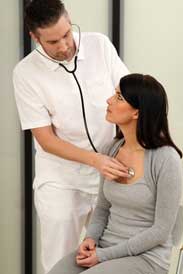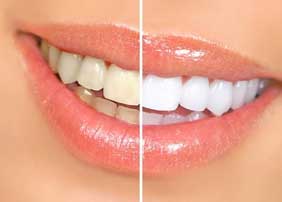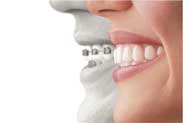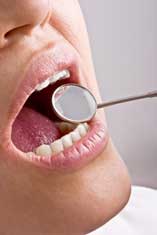 In today’s health conscious world, there is an increasing focus on maintaining a healthy mind as well as body. Studies now show just how complex our bodies are and how important daily maintenance is.
One topic that I find very interesting and important is the link between periodontal disease and heart disease. Cardiovascular disease affects more than 80 million people in the United States alone. It can present itself in the form of high blood pressure, heart attacks, angina pectoris, strokes or even heart failure. Periodontal disease, in the dental world is also incredibly prevalent.
Periodontal disease is the chronic inflammation and infection of the gums and surrounding tissues. Periodontal or gum disease can involve gingivitis (the inflammation of the gum tissue) or periodontitis (the loss or recession of bone aroud the teeth).
So what’s the connection?
Recent studies have found that the bacteria and inflammatory proteins that are present in gum disease are associated with an increase of blood vessel wall thickening, which is often found in cardiovascular disease.
The theory is that the bacteria and inflammatory proteins found in the mouths of people with periodontal disease make their way to the blood stream where they begin to affect the cardiovascular system.
How does this effect you?
Having good oral health is something we should all strive for, however, if you are at risk for, or have a family history of cardiovascular disease then you should be even more diligent with your oral hygiene. That means flossing and brushing regularly and seeing your dentist at least every 6 months. If you have periodontal disease be sure to tell your physician as well.]]>
In today’s health conscious world, there is an increasing focus on maintaining a healthy mind as well as body. Studies now show just how complex our bodies are and how important daily maintenance is.
One topic that I find very interesting and important is the link between periodontal disease and heart disease. Cardiovascular disease affects more than 80 million people in the United States alone. It can present itself in the form of high blood pressure, heart attacks, angina pectoris, strokes or even heart failure. Periodontal disease, in the dental world is also incredibly prevalent.
Periodontal disease is the chronic inflammation and infection of the gums and surrounding tissues. Periodontal or gum disease can involve gingivitis (the inflammation of the gum tissue) or periodontitis (the loss or recession of bone aroud the teeth).
So what’s the connection?
Recent studies have found that the bacteria and inflammatory proteins that are present in gum disease are associated with an increase of blood vessel wall thickening, which is often found in cardiovascular disease.
The theory is that the bacteria and inflammatory proteins found in the mouths of people with periodontal disease make their way to the blood stream where they begin to affect the cardiovascular system.
How does this effect you?
Having good oral health is something we should all strive for, however, if you are at risk for, or have a family history of cardiovascular disease then you should be even more diligent with your oral hygiene. That means flossing and brushing regularly and seeing your dentist at least every 6 months. If you have periodontal disease be sure to tell your physician as well.]]>
 Even America’s taste in beauty has changed over the years. In general, we’ve moved away from the windswept and overprocessed looks of the 70’s, 80’s and 90’s as seen with Michelle Pfiefer, Cindy Crawford and Farrah Fawcett, to focus on fresh-faced, more natural looking women like Jennifer Aniston, Jessica Alba and Angelina Jolie.
The New Vs. The Old Standards of Beauty:
Even America’s taste in beauty has changed over the years. In general, we’ve moved away from the windswept and overprocessed looks of the 70’s, 80’s and 90’s as seen with Michelle Pfiefer, Cindy Crawford and Farrah Fawcett, to focus on fresh-faced, more natural looking women like Jennifer Aniston, Jessica Alba and Angelina Jolie.
The New Vs. The Old Standards of Beauty:
- Full natural faces vs. angular faces with high cheekbones
- Round to almond shaped eyes with thicker less arched eyebrows vs. Cat eyes with skinny angular eybrows
- Straight noses with longer bridges vs. perky, ski-slope noses
- Full upper and lower lips vs. angular pouts w/ thinner upper lips and a fuller lower lip
- Natural straight white teeth vs. Bright white ear to ear smile with large uniform flat edged smiles.
 Whitening kiosks usually promise results of achieving “at least four shades lighter in less than an hour.” In order to achieve these promised results in a limited amount of time, a professional strength whitening agent with a high hydrogen peroxide content must be used. At that high concentration, you are at a higher risk of chemical burn of the gums, sensitivy or damage to your teeth.
Whitening procedures should always be done under the supervision of a dentist. Although the people at these kiosks may be wearing white coats, they are far from dental professionals. Usually they are unsupervised technicians working without the consultation of dental professionals.
The way kiosks get around the legal implications of performing this procedure unsupervised is that they instruct the “patient” how to place the bleaching agent on their own teeth, rather than place it them themselves. Since they don’t actually do the procedure themselves, they’re absolved from the legal implications of any negative side effects that may result.
It is Frangella Dental’s recommendation that whitening procedures be performed under a dentist’s supervision in a sterile environment. A dentist assesses each patient on an individual basis and predicts the outcome of treatment and any possible dangers.]]>
Whitening kiosks usually promise results of achieving “at least four shades lighter in less than an hour.” In order to achieve these promised results in a limited amount of time, a professional strength whitening agent with a high hydrogen peroxide content must be used. At that high concentration, you are at a higher risk of chemical burn of the gums, sensitivy or damage to your teeth.
Whitening procedures should always be done under the supervision of a dentist. Although the people at these kiosks may be wearing white coats, they are far from dental professionals. Usually they are unsupervised technicians working without the consultation of dental professionals.
The way kiosks get around the legal implications of performing this procedure unsupervised is that they instruct the “patient” how to place the bleaching agent on their own teeth, rather than place it them themselves. Since they don’t actually do the procedure themselves, they’re absolved from the legal implications of any negative side effects that may result.
It is Frangella Dental’s recommendation that whitening procedures be performed under a dentist’s supervision in a sterile environment. A dentist assesses each patient on an individual basis and predicts the outcome of treatment and any possible dangers.]]>
your questions about children’s oral health. Have additional questions for us? Visit Frangella Dental on Facebook or Twitter.
Is it okay to give children juice or is the sugar bad for their teeth?
Controlling a child’s diet is important for the prevention of cavities. You’ll want to make sure that your child is receiving the proper nutrition throughout the day but also keep their teeth in mind when doing so. If your child likes to sleep with a bottle, make sure that the bottle only has water in it. Sleeping with a bottle that contains sugary liquids can lead to baby bottle tooth decay. It is important that older children drink plenty of water and limit the amount of sugary beverages they drink including juice, energy drinks, and sodas. They are often full of sugar or can be acidic causing cavities, as well as acid erosion. Crunchy fruits and veggies can help clean a child’s teeth while supplying vitamins and nutrients that are good for your child’s overall health. After your child has a sugary drink, it is a good idea to brush their teeth. If that’s not possible, have them drink or rinse the mouth with water to cleanse the areas that the sugar that was deposited.How many times a day should kids brush their teeth and with what equipment?
We recommend that children brush their teeth at least twice a day; in the morning and at night. Night time is one of the most important times to brush because all the sugary foods and drink that your child has had during the day are left to sit on the teeth, undisturbed all those hours if not brushed. Infants may not have all their teeth yet. They also don’t know not to swallow toothpaste so we recommend you use a warm towel to wipe gums & teeth rather than brush with a toothbrush. For toddlers and small children, you should brush for them with a soft bristle toothbrush appropriate for their age. Children’s toothbrushes will have age groups listed on them to help you pick the right one. When your child is at the point where he/she will not swallow toothpaste, you can begin having him/her brush with a fluoride toothpaste. As your child gets older, he/she will want to brush his/her own teeth but may not have the proper dexterity to reach all the areas of the mouth and often just do a back and forth motion on the front of the teeth. You should always follow up and brush for them when they’re done. This helps to make sure that the teeth are clean but also continues to reinforce the proper way to brush.Should I floss my child’s teeth or is that not important until the permanent teeth come in?
We recommend that a parent floss a child’s teeth at least once a day. You may be wondering what there is to floss if there are spaces between the child’s teeth but the most important thing is to get below the gumline, to clean where the toothbrush doesn’t reach. You can pick up flossers specially made for children in local drugstores.How much fluoride should I give my child? Can flouride be bad for teeth?
Fluorosis is something that can happen if a child is getting too much fluoride for their height and weight during tooth development. Your dentist or general physician will prescribe a fluoride vitamin during these years of development and account for fluoride that is already in your water.How bad is a pacifier or thumb-sucking?
Children usually give up these habits before the age that adult teeth begin to come in so it has no long lasting dental result. If a child is engaging in these habits while the adult teeth are erupting it can cause them to be malpositioned and pushed forward. Adult teeth begin to erupt in a child around the ages of 5-6 years old, so it is a good idea to try and wean your child off of these habits before then.]]>  If it’s decided that your child needs orthodontic treatment, traditional braces are the most common way to straighten a child’s teeth from ages 8 to12 years old.
For teenagers, there is an alternative to braces called Invisalign. Invisalign moves the teeth using clear aligners. The clear aligners are removable so that they can be taken out for eating, drinking, and social events. In order for your child to be considered for Invisalign, his/her mouth must have fully transitioned from baby teeth to permanent teeth, which is typically complete by 12 years old for most children.
Because Invisalign is removable, teenagers may have compliance issues with the treatment. I often find teens with responsible personalities that truly do want to straighten their teeth to be the most successful with treatment.
For additional information on treatment options or to schedule a consultation, call us at (212) 245-2888.]]>
If it’s decided that your child needs orthodontic treatment, traditional braces are the most common way to straighten a child’s teeth from ages 8 to12 years old.
For teenagers, there is an alternative to braces called Invisalign. Invisalign moves the teeth using clear aligners. The clear aligners are removable so that they can be taken out for eating, drinking, and social events. In order for your child to be considered for Invisalign, his/her mouth must have fully transitioned from baby teeth to permanent teeth, which is typically complete by 12 years old for most children.
Because Invisalign is removable, teenagers may have compliance issues with the treatment. I often find teens with responsible personalities that truly do want to straighten their teeth to be the most successful with treatment.
For additional information on treatment options or to schedule a consultation, call us at (212) 245-2888.]]>
Andrew D. Frangella DDS, FICOI Receives 2011 Fellowship Award from the Academy of General Dentistry
NEW YORK (August 8, 2011)
The Academy of General Dentistry (AGD), a professional association of more than 37,000 general dentists dedicated to staying up to date in the profession through continuing education to better serve the public, is pleased to announce that Andrew D. Frangella DDS, FICOI, FAGD of Frangella Dental in New York, New York, received the association’s 2011 Fellowship award during the AGD 2011 Annual Meeting & Exhibits, held July 28 to 31 in San Diego, California. The Fellowship award is presented to dentists who seek to provide the highest quality of dental care by remaining current in their profession. To accomplish this goal, Dr. Frangella completed 500 hours of continuing dental education, passed a comprehensive exam and fulfilled three years of continuous membership in the AGD. As a recipient of the Fellowship award, Dr. Frangella joins more than 7,000 active AGD Fellows who understand that providing great smiles and good oral health for their patients are the result of going above and beyond basic requirements. “We are proud to honor Dr. Frangella for his commitment to the profession,” says AGD President Howard Gamble, DMD, FAGD. “He has distinguished himself professionally among his peers and demonstrates the characteristics of a role model to both his fellow dentists and to the members of the community.” Dr. Frangella graduated from New York University’s College of Dentistry in 2005 and currently practices general and cosmetic dentistry at Frangella Dental in Midtown, Manhattan.About the Academy of General Dentistry
The Academy of General Dentistry (AGD) is a professional association of more than 37,000 general dentists dedicated to staying up to date in the profession through continuing education to better serve the public. Founded in 1952, the AGD has grown to become the second largest dental association in the United States, and it is the only association that exclusively represents the needs and interests of general dentists. More than 772,000 persons in the United States are employed directly in the field of dentistry. A general dentist is the primary care provider for patients of all ages and is responsible for the diagnosis, treatment, management and overall coordination of services related to patients’ oral health needs. For more information about the AGD, please visit www.agd.org.About Frangella Dental
Frangella Dental is a Manhattan family practice of 3 siblings, Andrew D. Frangella DDS, FICO, FAGD, Tina M. Frangella DDS, and Laura O. Frangella, DDS, utilizing state-of-the-art technology and cutting-edge techniques to cover a broad spectrum of preventative & cosmetic dental procedures.]]>your questions about children’s oral health. Have a question for us? Visit Frangella Dental on Facebook.
When should I schedule my child’s first dental appointment?
As soon as a child’s teeth begin to erupt, they should start seeing a dentist. The goal is to bring your child early so that he/she gets accustomed to the environment and learns what to expect at the office and during a check-up.
It is also important to bring children early so that they can be evaluated for common dental issues such as baby bottle tooth decay and any problems with their bite for early intervention if necessary. 
What can we expect at our child’s first dental appointment? The first visit is all about getting acclimated to the dental office. Even if we only get as far as having the child sit in the chair and allow me to look with a mirror, it’s still considered a successful visit.
If you start your child at the right age and are performing proper home care, usually they will not need anything other than a routine cleaning and exam.
The first dental visit will include a cleaning and dental exam. X-rays typically are not taken until the age of 5 or 6 once the child begins to have eruption of their permanent teeth.
It is important to bring your child in every 6 months. This will help prevent future tooth decay but also hopefully get your child so comfortable with the dentist that they are actually excited to visit for their cleanings.
How can I ease my child’s anxiety of visiting the dentist?
It helps if a parent brings the child to one of their own cleanings prior to the child’s, so that he/she knows what to expect and can see the parent comfortable and at ease.
A parent should never use going to the dentist as a punishment (i.e. “If you don’t brush your teeth you’re going to go to the dentist and they’re going to give you a shot”).
Most importantly, be a good example. Children’s fear of the dentist is often a learned one. If you show you are afraid and anxious, it is likely that they will be afraid and anxious.
How do I choose a dentist that’s right for my child?
When evaluating dentists, you want to find one who regularly treats children. Besides their dental ability, it is equally important to find someone who your child will be comfortable with.
The way your child perceives their dentist and dental visit, often sets the tone for how they feel about the dentist as an adult. Therefore it is very important that you find the right doctor for your child. Often, a parent will find a dentist who they themselves are comfortable with and who also regularly treats children in their practice.]]>
How can I ease my child’s anxiety of visiting the dentist?
It helps if a parent brings the child to one of their own cleanings prior to the child’s, so that he/she knows what to expect and can see the parent comfortable and at ease. A parent should never use going to the dentist as a punishment (i.e. “If you don’t brush your teeth you’re going to go to the dentist and they’re going to give you a shot”). Most importantly, be a good example. Children’s fear of the dentist is often a learned one. If you show you are afraid and anxious, it is likely that they will be afraid and anxious.How do I choose a dentist that’s right for my child?
When evaluating dentists, you want to find one who regularly treats children. Besides their dental ability, it is equally important to find someone who your child will be comfortable with. The way your child perceives their dentist and dental visit, often sets the tone for how they feel about the dentist as an adult. Therefore it is very important that you find the right doctor for your child. Often, a parent will find a dentist who they themselves are comfortable with and who also regularly treats children in their practice.]]> A common question patients ask me is, “Am I at risk for oral cancer and what can I do to prevent it?”
 Oral cancer is a form of cancer that occurs in the mouth.
It most frequently presents on the tongue, soft palate (roof of the mouth), floor of the mouth, lips, and the gums.
Although the exact cause of oral cancer is unknown, there are known risk factors such as excessive exposure to the sun, tobacco, and alcohol. There is also research that suggests that some forms of oral cancer may be caused by the human papilloma virus (HPV).
A hallmark of our age is the hands on approach many Americans are taking with their health care. The advent of sites like WebMD have led to more educated and healthier patients. By avoiding known risk factors and being more aware of your general health, your doctors are better able to diagnose and treat health problems earlier.
Oral cancer is a form of cancer that occurs in the mouth.
It most frequently presents on the tongue, soft palate (roof of the mouth), floor of the mouth, lips, and the gums.
Although the exact cause of oral cancer is unknown, there are known risk factors such as excessive exposure to the sun, tobacco, and alcohol. There is also research that suggests that some forms of oral cancer may be caused by the human papilloma virus (HPV).
A hallmark of our age is the hands on approach many Americans are taking with their health care. The advent of sites like WebMD have led to more educated and healthier patients. By avoiding known risk factors and being more aware of your general health, your doctors are better able to diagnose and treat health problems earlier.
Tips to decrease your chances of oral cancer and/or catch it early:
- Be observant, if you see something that doesn’t look right in your mouth, get it checked out immediately. Oral cancer is typically painless in the early stages and is normally represented by red, white or discolored lesions, patches or lumps in or around the mouth.
- Avoid common rish factors such as smoking, excessive drinking, and excessive sun exposure.
- See your dentist regularly! Early diagnosis is key for oral cancer treatment. Ideally, you should be seeing your dentist every six months for routine checkups. During your oral cancer screenings, your dentist will check your neck, head, cheeks and oral cavity for any lumps, or irregular tissue changes

- If you’re using a manual brush, it should always be a soft bristle toothbrush. I wouldn’t recommend buying a hard bristle one unless you’re planning to use it to clean the grout on your bathroom tiles! Hard bristles are too harsh for teeth and not necessary to do an effective cleaning job.
- The proper technique is to move the brush over the teeth in a circular motion. Never use a front to back “sawing” motion.
- A typical brushing routine should include brushing at least two to three times a day for two minutes, breaking up the time evenly amongst the different areas of the mouth.
- If you’re using a manual toothbrush, we recommend switching to an electric one. They often have two-minute timers built in with a beep to remind you to switch to the next part of your mouth and give a nice uniform amount of pressure. Electric toothbrushes do most of the work and help you resist the urge to scrub too hard.
Frangella Dental
Offering advanced techniques in Cosmetic and General Dentistry in New York City.
200 W. 57th Street, Suite 1405
New York, NY 10019
(212) 245-2888
care@drfrangella.com
